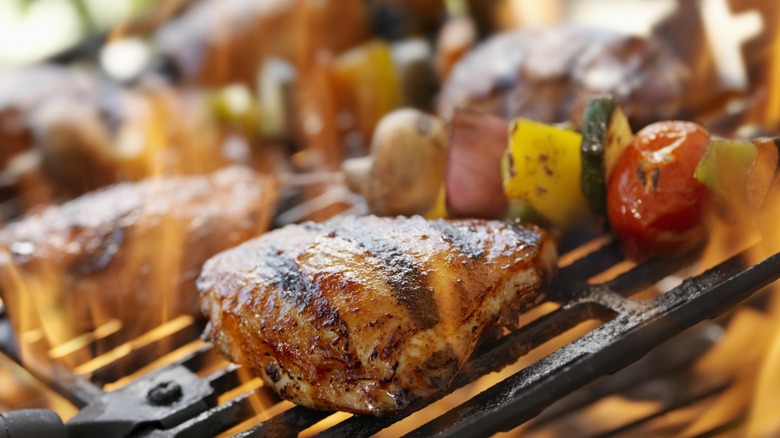When Grilling Chicken, Be Sure To Always Put Your Dark Meat On First
When it comes to grilling or barbecuing, there's nothing wrong with a great steak, but chicken is where it's at — especially since (as USA Today pointed out) it's the most researched cut of meat among foods that'll hit a BBQ.
This may indicate two things: People love throwing chicken into a pit, but might not know how to cook it correctly. After all, a few mistakes need to be avoided when grilling poultry, and one of the more often overlooked steps involves dark meat. When barbecuing chicken thighs or legs, people typically cook them alongside breasts or wings (which isn't necessarily wrong), but the problem is they usually get treated the same. In short, because the nature of each cut of meat on a bird is different, you should place the dark meat on the grill first.
There are various reasons why this is important. However, the most significant are because of dark meat's bone, skin, and muscle composition, which differ from white meat.
Why chicken's dark meat should go on the grill first
A chicken's muscles are distinguished between white and dark meat because each group comprises a more significant amount of white or red fibers. The white fibers are predominately used for rapid actions, while the red fibers are for lengthy activities, like staying upright. Both muscle classes include the two, but the ratios vary. As a result, dark meat has more myoglobin, made up of iron proteins that store oxygen in the meat's cells, producing color variance. However, it also affects the fat content.
According to the Academy of Nutrition and Dietetics, skinless dark meat has three times the amount of fat compared to white meat. This may not be ideal for health-conscious individuals, but it dramatically affects flavor and cooking times. This is especially true if the skin and bone are still attached, and they should be. The extra fat keeps the dark meat from drying out as fast because it insulates the protein. Moreover, when cooking a cut of bone-in meat, the bone marrow leeches into the protein, producing a more savory taste.
Nevertheless, bone and skin increasing the cooking time. As a result, although the USDA recommends cooking all chicken until it reaches an internal temp of 165 degrees Fahrenheit, the National Chicken Council recommends cooking dark meat to 170 degrees Fahrenheit, so thighs and legs should go on the grill first.
How to get crispy chicken skin on grilled dark meat
Although a chicken's skin and bone provide additional protection and flavor, it isn't always effortless to transform the skin into a nice crackling cap that everyone will enjoy, especially on the grill. Nevertheless, some tricks to making crispy chicken thighs and legs exist.
While most recommendations revolve around marinating or stretching the thigh and leg skin over the meat, which are excellent methods and should be included, another focuses on keeping the skin dry. Although Chef Kathy Millard was referring to roasting chicken when she talked to Food&Wine about the subject, it's something worth keeping in mind when grilling, especially since it can be done in tandem with a marinade as long as the skin doesn't soak in it. As a result, she places the protein in an open container in a refrigerator for at least 24 hours so the meat and skin can cure.
When creating crispy skin, the fat undergoes the Maillard reaction, caramelizing when applied to high heat, and removing excess moisture. So, put the chicken on a grill with the skin facing down, but ensure the flames aren't rocket-hot. A medium-to-medium-high heat (roughly around 325 degrees to 375 degrees Fahrenheit) is preferred because anything higher than this will lead to burning and dryness. Either way, following these steps with dark meat on the grill first should secure some nicely grilled chicken thighs and legs.


